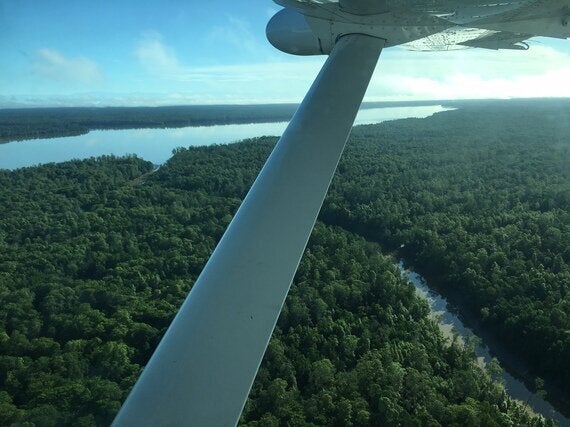
Having spent the last twenty years of my life traveling for a living, I'm getting to the stage where I'm returning to places repeatedly, and getting a sense of how they're changing over time. The results are inevitably depressing. On my most recent expedition, I returned to New Guinea, specifically the Asmat region of Indonesian-controlled Papua, a region I traveled extensively in 1997. Having seen the devastation wrought by slash and burn, and palm oil plantations in the other Indonesian provinces of Sumatra and Kalimantan, I was braced for the worst. Nothing could have prepared me for what I found there.
My 1997 solo expedition was something of a heroic failure, recorded in my book 'Looking for Adventure'. While I found sublime indigenous cultures, hunter-gatherer lifestyles, and miles and miles of pristine rainforest, there were also signs that the Asmat region was about to be truly plundered. As I journeyed down the Siretsj River, the lush green jungle was broken every few hours by clear-felled smouldering wastelands. There were logging camps and Wild West frontiers-ville forestry towns, where dangerous-looking armed men floated bundles of huge ironwood trees downriver.
Near two decades later, my team began this section of the expedition where the highlands and lowlands meet, in a glorious Casuarina and Araucaria evergreen forest, with towering 4000 m peaks seething with mist beyond. It looked more like Alaska than New Guinea, and felt like the end of the Earth. There was no sign whatsoever of people, or of the demolition that inevitably follows human greed. But that was all to change. Sometime downriver. Surely? Mile after mile, day after day we continued downstream, squadrons of hornbills swooping noisily overhead, cockatoos and parakeets in chattery flocks, cicadas screamed like fire engine sirens, and trees were illuminated at dusk with a million fireflies. It felt as if we were in a fairytale Christmas tree plantation. Cassowary footprints lined the beaches, crocodiles dashed into the water at our approach, and gigantic butterflies from neon blue to malachite green flounced about like maiden's hankies. But where were the humans and their wanton destruction? Perhaps once a day we would see old hunting camps and trading posts, but they had been deserted for what seemed like years, and being reclaimed by the forest. Eventually we found ourselves at a village, set apart by the huge Clan longhouse they had just constructed. They had once had an airstrip and helipad, but these had long since grown over. The people greeted us like long-lost family, were happy and healthy, and reported that although modernity had come and gone, their lives were better than in the past. Their river was full of fish, their endless forests full of game. They could have education and healthcare if they wanted it, but they were also free to maintain their proud connection to the past and their traditions. At night they sat around fires in the longhouse playing on exquisitely carved ancient ironwood drums. I cautiously asked if I might be able to bargain to buy one, but was rewarded with a smile; they were memories of their ancestors and not for sale at any cost.
We continued on down to the coast, and never saw a single sign of the environmental degradation I was expecting. When we reached the Casuarina Coast, we flew for an hour over what must be one of the largest unbroken stretches of rainforest outside of the Amazon basin. Not a single road, village or plantation. So what happened? Time magazine reported in 2014 that Indonesia has the highest rate of deforestation in the world, with SE Asia as a whole losing forests faster than Brazil. And on my original trip in 1997, the whole of Southeast Asia was covered in a thick smog caused by the uncontrolled burning of forests such as these; in some places you could see only a few hundred metres through the haze.
It appears that the Asmat region (in size around 32,000 km or about the size of Belgium) has kind of been forgotten. In the 80s and 90s when I was here last, legal and illegal logging operations came in and took all the big and valuable trees out. However, the Asmat is a vast alluvial swamp, with much of the area being flooded by tides, and some of the rest going under in the rainy season, which makes it unsuitable for agriculture. The spindly Eucalypts, palms and pines were not worth the effort of wholesale pillage. So choice ironwoods were taken, but robust rainforest species quickly bounced back, in the greatest example of ecological succession I've ever seen. Granted, these are brutal, tangled secondary forests, and the biodiversity is no doubt reduced, but the unbroken ocean of green nearly made me weep with joy. I've never seen so many birds, or heard so many frog calls, and never travelled so far with so little sign of human hands.
Another pleasant surprise awaited me at the coastal town of Agats, the largest in the regency. When I was last here, it was a tiny village of stilted fishing shacks, with deathtrap plankways leading between them, electricity for an hour some evenings, and little contact with the outside world. Now it has swelled to a decent-sized town, and would surely be blighted by the curse of all growing Asian towns; the motorbike. Perhaps my most potent example of this is Hanoi in Vietnam. When I first went there in 1991, Hanoi was a silent city, where you could be lulled to sleep by the whirr of a million bicycle wheels. Returning in 2001, it had become a roaring choking thunder town, with the demon moped being the main culprit. Entire families were carried around on mopeds, along with pigs, chickens and three-piece lounge suites. The noise was incessant, the air so thick you could ladle it out and serve it as noodle soup. I knew that Agats would have gone the same way.
In fact as we pulled up at the dock, the silence was almost spooky. It turned out that ten years ago, when Agats first started to build roads, the regency declared that as they were starting from scratch they would do it right. So this small town in the back end of nowhere has zero motorized transport. By law only electric mopeds, bicycles and handcarts are allowed. Papuan and Indonesian women sit side by side in the market selling betel nut and jackfruit, and smile with a warmth and surprise that suggests tourists are a welcome, but not regular sight here. I'm not going to suggest its perfect, there's plenty of rubbish, longtail boats still chug around the harbor, and it's a challenge avoiding being run over by mopeds you can't hear. But it's a great start.
I've grown accustomed over the years to dreading going back. To knowing that the places I first explored in the early days of my career will be horrible sullied reflections of my rosiest memories, that I will end up feeling crushed, and demotivated as a result. What I saw of the Asmat was a beacon of light. It was a sign of quite how dramatically environments bounce back if given a chance. I'm not suggesting all of Papua is the same - I know it isn't - but sometimes we need good news stories to remind ourselves that all is not lost, to know that nature is a born survivor, and that conservation efforts are very, very worthwhile.
